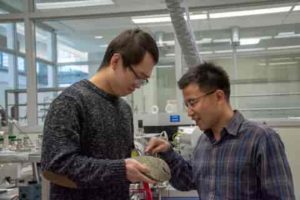
Eclogitic Diamonds
Eclogitic diamonds formed in Earth’s mantle originate from oceanic crust, rather than marine sediments as commonly thought, according to a new study from University of Alberta geologists.
Diamonds are found in two types of rocks from Earth’s mantle: peridotite and eclogite. Peridotite is the most common type of mantle rock. Eclogite forms from igneous oceanic crust that together with a thin veneer of overlying marine sediment has been brought deep into the mantle through a process known as subduction. Even though, many researchers thought eclogitic diamonds formed with carbon from marine sediment, a large carbon reservoir. The new study turns this theory on its head.
“The key indices for diamond source tracing are the ratios of stable isotopes, which are atoms that have the same proton number but different neutron number, of carbon and nitrogen in diamond,” explained Long Li, associate professor in the Department of Earth and Atmospheric Sciences and principal investigator of the study. “These isotopic ratios act as source fingerprints. Marine sediment was invoked as the source of eclogitic diamonds mainly because their highly variable carbon isotopic ratios match the signature of organic matter in sediment. But the sediment source has difficulty in explaining the highly variable nitrogen isotopic signature of eclogitic diamonds.”
The study investigated 80 drill samples of igneous oceanic crust from around the world, supplied by the International Ocean Discovery Program. The researchers, led by PhD student Kan Li, conducted extensive analyses to examine the carbon budgets and isotopic signatures of the major subducting oceanic slabs.
“We verified that the oceanic crust is a large reservoir for carbon, mostly in form of carbonate. What really surprised us is that the bulk carbonate in subducting igneous oceanic crusts in part shows a similar isotopic signature to organic matter in sediment,” said Kan Li. “It then makes much more sense for igneous oceanic crust, which also contains isotopically highly variable nitrogen, to serve as the source of eclogitic diamonds in Earth’s mantle.”
“This study addresses a long-standing puzzle in diamond genesis and the deep carbon cycle,” said Long Li. “The deep carbon cycle, a process that circulates carbon from Earth’s surface to the deep interior and back again, has strong impact on mantle chemistry and surface environment. Our study shows that oceanic crust plays a much larger role in this than previously thought.”
“This research changes the way that we think recycled carbon gets into diamonds and changes what we think about how carbon in general is recycled into the Earth. It makes us re-evaluate how diamonds are formed and what the dominant source of carbon is in both the shallow and very deepest parts of Earth’s mantle,” added Graham Pearson, professor,Henry Marshall Tory Chair, and Canada Excellence Research Chair Laureate.
Reference:
Kan Li, Long Li, D. Graham Pearson, Thomas Stachel. Diamond isotope compositions indicate altered igneous oceanic crust dominates deep carbon recycling. Earth and Planetary Science Letters, 2019; 516: 190 DOI: 10.1016/j.epsl.2019.03.041
Note: The above post is reprinted from materials provided by University of Alberta.










